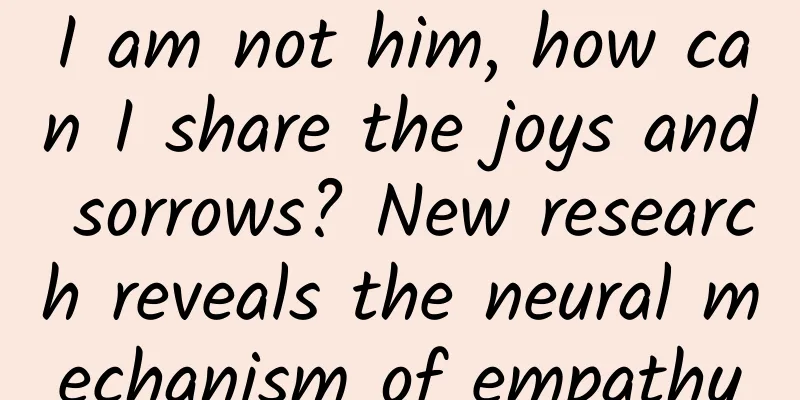I am not him, how can I share the joys and sorrows? New research reveals the neural mechanism of empathy

|
Good communication is often based on empathy and understanding. However, as the saying goes, "one knows the coldness and warmth of water only after drinking it." We are not others, so how can we empathize and respond to other people's emotions? In fact, scientists have discovered that there is a neural mechanism in the human brain that resonates with the emotions of others. Copyright images in the gallery. Reprinting and using them may lead to copyright disputes. Recently, a study found that a group of neurons in the brain have the function of "emotional memory", which can "record" the emotions you have experienced and regulate your response to the emotions of others . The study was published in Nature Neuroscience on December 3, 2024, and the author is a scientific research team led by Francesco Papaleo of the Italian Institute of Technology (IIT). Psychological research has found that human responses to other people's emotions are strongly influenced by our own past emotional experiences. When we observe another person experiencing a similar emotional situation as ourselves, such as feeling stressed, we may have two different reactions. On the one hand, we may empathize, enhance our ability to understand others, and become more sensitive to their emotions. On the other hand, it may cause self-pain, causing us to avoid others. The study, using mice, found that a similar phenomenon occurs in animals: recalling negative experiences strongly affects responses to the same emotional state in others. This suggests that even animals can specifically recognize emotional states and respond accordingly without directly seeing the triggering stimulus. The study found that whether mice became more affectionate or avoided each other after empathy depended on different factors. "These responses were influenced by the estrous cycle in females and by dominance in males," the study wrote. Papaleo's team identified a key role for the prefrontal cortex in these social cognitive processes . They found a specific group of neurons that are key regulators of emotional responses to others based on emotional self-experience. These neurons produce corticotropin-releasing factor (CRF), a molecule involved in stress response mechanisms. The study found that they function as an emotional memory that influences responses to socio-emotional stimuli. The researchers used in vivo micro-terminal calcium imaging to find that only when they experienced similar negative self-experiences (such as stress) did the CRF neurons in the medial prefrontal cortex respond more actively to the stress of others. When the researchers knocked out the CRF gene in mice through genetic technology to inhibit its expression in the medial prefrontal cortex, the mice that had experienced stress had a reduced response to the stressful emotions of other mice. The study also found through optogenetic experiments that if these neurons are activated to a higher degree, the behavior of mice after empathy will change from preference and approach to avoidance. “ Understanding these brain mechanisms in this precise way could help illuminate many aspects of human responses to others’ emotions ,” the study states, “for example, why some people tend to avoid others under stress, while others are more inclined to help others, based on past emotional experiences.” The research provides new insights into conditions such as post-traumatic stress disorder (PTSD), autism and schizophrenia. Identifying specific brain mechanisms that regulate empathic responses could help clinical research develop new targeted therapies and could also help improve abnormal emotional responses observed in a variety of psychiatric conditions. Planning and production Source: The Paper Editor: Wang Mengru Proofread by Xu Lailinlin |
Recommend
The efficacy and function of goat oil
Goat oil is a famous traditional Chinese medicina...
Is your child always procrastinating? The real reason is not as simple as you think
The child is too slow, I have to push him! ! In f...
"Every additional CT scan increases the risk of cancer by 43%" has become a hot topic! Should CT scans still be performed?
"For every additional CT scan, the risk of c...
The efficacy and function of water bean paste
Recently, major TV channels have launched various...
The efficacy and function of Mai Nu
Do you know what Mai Nu is? If you know, do you u...
Drink this bowl of "bitter water" and your anger will subside
I hate Mondays the most in life. I have outpatien...
Summer fraud prevention! @Teens, be careful not to become a new type of fraud tool
"Students, I have a part-time job for the su...
How to take Tongkat Ali most effectively?
Tongkat Ali can better help us improve our body&#...
Can the magic medicine that promises “immortality” and “longevity” really extend life?
If someone says: There really is an elixir of lif...
The 110th anniversary of Qian Xuesen’s birth | What did he leave us?
Creative team: China Science and Technology Museu...
"I am your wall breaker!" Air & Water: ...
Did you know that there is a "wall" bet...
The efficacy and function of Matsutake wine
The main ingredient of Matsutake wine is Matsutak...
The efficacy and function of cone vine
Many people are not very clear about the effects ...
Do you hold your phone with your little finger? Doctors warn...
Have you ever observed carefully? How do you hold...
The efficacy of the golden wire hanging gourd
Golden Thread Gourd is a perennial herb, 20-40 cm...









